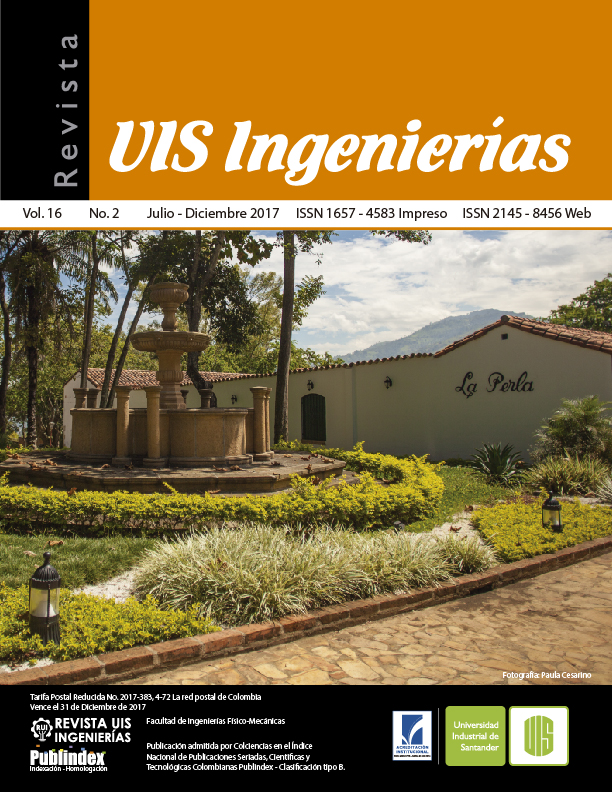Damage detection methodology in metallic structure by experimental modal analysis techniques and PSO
Published 2017-05-30
Keywords
- Modal analysis,
- optimization algorithm,
- dynamic characterization,
- vibration based damage identification techniques (VBDIT),
- finite element method
How to Cite
Abstract
With the objective of improving the production systems reliability the companies have developed methodologies to detect incipient damages. The metallic structures are usually checked by visual inspection procedure which is not be able to detect emerging falls. The purpose of the present work is to develop a novel methodology based on modal testing analysis and particle swarm optimization algorithm to detect falls in these structures. A physical model was built and it was studied applying the modal testing techniques. A numerical model was stablished by Finite Element Method (MEF). The algorithm was executed, and the results were compared with the experimental results. The methodology was validated and falls were identified for different levels damages.
Downloads
References
- H. G. Sánchez A, D. M. C. Marulanda, and E. G. Florez, “Application of Vibration Based Damage Identification Techniques on Metallic Structures,” Adv. Mater. Res., vol. 875–877, pp. 875–879, 2014.
- H. G. Sánchez A., “Modelo analítico para el estudio de rotores flexibles,” Rev. UIS Ing., vol. 9, no. 1, pp. 69–76, 2010.
- J. M. Pachón, O. A. González, and H. G. Sánchez, “Detección de daños en una armadura unidimensional por medio del algoritmo de optimización de la luciérnaga y elementos finitos,” Av. Investig. en Ing., vol. 13, no. 1, pp. 1–7, 2017.
- A. Katunin, K. Dragan, and M. Dziendzikowski, “Damage identification in aircraft composite structures: A case study using various non-destructive testing techniques,” Compos. Struct., vol. 127, pp. 1–9, Sep. 2015.
- M. P. Paulraj, S. Yaacob, M. S. A. Majid, M. N. F. M. Kazim, and P. Krishnan, “Structural Steel Plate Damage Detection using Non Destructive Testing, Frame Energy based Statistical Features and Artificial Neural Networks,” Procedia Eng., vol. 53, pp. 376–386, 2013.
- D.-J. Han, “Generalized modal balancing for non-isotropic rotor systems,” Mech. Syst. Signal Process., vol. 21, no. 5, pp. 2137–2160, 2007.
- S. Živanović, A. Pavic, and P. Reynolds, “Modal testing and FE model tuning of a lively footbridge structure,” Eng. Struct., vol. 28, no. 6, pp. 857–868, 2006.
- A. delli Carri, B. Weekes, D. Di Maio, and D. J. Ewins, “Extending modal testing technology for model validation of engineering structures with sparse nonlinearities: A first case study,” Mech. Syst. Signal Process., vol. 84, pp. 97–115, 2017.
- G. Mansour, K. Tsongas, and D. Tzetzis, “Modal testing of nanocomposite materials through an optimization algorithm,” Measurement, vol. 91, pp. 31–38, 2016.
- A. D. Nembhard and J. K. Sinha, “Comparison of experimental observations in rotating machines with simple mathematical simulations,” Measurement, vol. 89, pp. 120–136, 2016.
- C. R. Farrar and S. W. Doebling, “An overview of modal based damage identification methods,” Struct. Damage Assess. Using Adv. Signal Process. Proced., 1997.
- K.-C. Chang and C.-W. Kim, “Modal-parameter identification and vibration-based damage detection of a damaged steel truss bridge,” Eng. Struct., vol. 122, pp. 156–173, Sep. 2016.
- K. Moslem and R. Nafaspour, “Structural Damage Detection by Genetic Algorithms,” AIAA J., vol. 40, no. 7, pp. 1395–1401, Jul. 2002.

